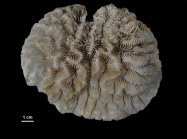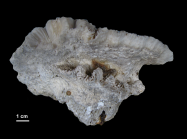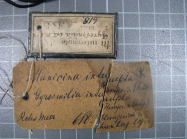WoRMS taxon details
Gyrosmilia interrupta (Ehrenberg, 1834)
207496 (urn:lsid:marinespecies.org:taxname:207496)
accepted
Species
Manicina interrupta Ehrenberg, 1834 · unaccepted > superseded combination (basionym)
marine, fresh, terrestrial
(of Manicina interrupta Ehrenberg, 1834) Ehrenberg, C. G. (1834). Beiträge zur physiologischen Kenntniss der Corallenthiere im allgemeinen, und besonders des rothen Meeres, nebst einem Versuche zur physiologischen Systematik derselben. <em>Abhandlungen der Königlichen Akademie der Wissenschaften, Berlin.</em> 1: 225-380., available online at https://www.biodiversitylibrary.org/page/29725862 [details]
Holotype (of Manicina interrupta Ehrenberg, 1834) ZMB...
Holotype (of Manicina interrupta Ehrenberg, 1834) ZMB Cni749 [details]
Description Colonies are up to 30 cm across. They are encrusting, rarely attaining a height of over 3 cm. Valleys are about 8 mm wide...
Description Colonies are up to 30 cm across. They are encrusting, rarely attaining a height of over 3 cm. Valleys are about 8 mm wide or less, and septa of adjacent valleys often join at the top of the thin wall, where their line of contact is marked by a thin ridge. Septa curve slightly laterally, and have a radius over the top of the wall of 2-3 mm. They plunge steeply, and there is no columella. The species is common at mid- to deep depths on all reef slopes. The species prefers recesses and small holes in the reef, which makes it more inconspicuous although it is fairly abundant. It is found equally commonly in moderately turbid as well as clear water reef slopes. Living corals are always shades of brown. Tentacles are retracted during the day. (Sheppard, 1998 <308>)
Colonies are circular and slightly domed, have meandering radiating valleys. The light skeleton has the enlarged septa found in Plerogyra and Physogyra, but lacks their characteristic vesicles. Colour: usually a chocolate brown, occasionally with a greenish hue. Habitat: diverse. (Richmond, 1997) [details]
Colonies are circular and slightly domed, have meandering radiating valleys. The light skeleton has the enlarged septa found in Plerogyra and Physogyra, but lacks their characteristic vesicles. Colour: usually a chocolate brown, occasionally with a greenish hue. Habitat: diverse. (Richmond, 1997) [details]
Hoeksema, B. W.; Cairns, S. (2024). World List of Scleractinia. Gyrosmilia interrupta (Ehrenberg, 1834). Accessed through: World Register of Marine Species at: https://www.marinespecies.org/aphia.php?p=taxdetails&id=207496 on 2024-04-24
Date
action
by
![]() The webpage text is licensed under a Creative Commons Attribution 4.0 License
The webpage text is licensed under a Creative Commons Attribution 4.0 License
original description
(of Manicina interrupta Ehrenberg, 1834) Ehrenberg, C. G. (1834). Beiträge zur physiologischen Kenntniss der Corallenthiere im allgemeinen, und besonders des rothen Meeres, nebst einem Versuche zur physiologischen Systematik derselben. <em>Abhandlungen der Königlichen Akademie der Wissenschaften, Berlin.</em> 1: 225-380., available online at https://www.biodiversitylibrary.org/page/29725862 [details]
context source (Hexacorallia) Fautin, Daphne G. (2013). Hexacorallians of the World. (look up in IMIS) [details]
basis of record Veron JEN. (1986). Corals of Australia and the Indo-Pacific. <em>Angus & Robertson Publishers.</em> [details]
additional source Cairns, S.D., B.W. Hoeksema & J. van der Land. (1999). Appendix: List of extant stony corals. <em>Atoll Research Bulletin.</em> 459: 13-46.
page(s): 22 [details]
additional source Cairns, S.D., B.W. Hoeksema & J. van der Land. (2007). as a contribution to UNESCO-IOC Register of Marine Organisms. (look up in IMIS) [details]
additional source Veron JEN. (2000). Corals of the World. Vol. 1–3. <em>Australian Institute of Marine Science and CRR, Queensland, Australia.</em> [details]
additional source Budd AF, Fukami H, Smith ND, Knowlton N. (2012). Taxonomic classification of the reef coral family Mussidae (Cnidaria: Anthozoa: Scleractinia). <em>Zoological Journal of the Linnean Society.</em> 166 (3): 465-529., available online at https://doi.org/10.1111/j.1096-3642.2012.00855.x [details]
additional source Matthai G. (1928). A Monograph of the Recent meandroid Astraeidae. <em>Catalogue of the Madreporarian Corals in the British Museum (Natural History).</em> 7: 1-288, pls. 1-72. [details] Available for editors [request]
[request]
additional source Veron, J. E. N. (2000). Corals of the World, Volume II: Families Astrocoeniidae, Pocilloporidae, Euphyllidae, Oculinidae, Meandrinidae, Siderastreidae, Agariciidae, Fungiidae, Rhizangiidae, Pectiniidae, Merulinidae, Dendrophylliidae, Caryophylliidae. Australian Institute of Marine Science. Townsville., volume 2, pp. 429.
page(s): 128 [details]
additional source Harrison, R. M.; Poole, M. (1909). Marine fauna from the Kerimba Archipelago, Portuguese East Africa, collected by Jas. J. Simpson, M.A., B.Sc., and R. N. Rudmose-Brown, BSc., University of Aberdeen: Madreporaria. Proceedings of the Zoological Society of London, 3, 913-917
page(s): 915 [details]
additional source Sheppard, C. R. C. (1985). Fringing reefs in the southern region, Jeddah to Jizan. Fauna of Saudi Arabia, 7, 37-58
page(s): 46 [details]
additional source Kühlmann, D. H. H. (2006). Die Steinkorallensammlung im Naturhistorischen Museum in Rudolstadt (Thüringen) nebst ökologischen Bemerkungen. Rudolstädter Naturhistorische Schriften, 13, 37-113
page(s): 63, 112 [details]
new combination reference Klunzinger CB. (1879). Die Korallthiere des Rothen Meeres, 3. Theil: Die Steinkorallen. Zweiter Abschnitt: Die Asteraeaceen und Fungiaceen. 1-100, pls. 1-10. Gutmann, Berlin. [details]
context source (Hexacorallia) Fautin, Daphne G. (2013). Hexacorallians of the World. (look up in IMIS) [details]
basis of record Veron JEN. (1986). Corals of Australia and the Indo-Pacific. <em>Angus & Robertson Publishers.</em> [details]
additional source Cairns, S.D., B.W. Hoeksema & J. van der Land. (1999). Appendix: List of extant stony corals. <em>Atoll Research Bulletin.</em> 459: 13-46.
page(s): 22 [details]
additional source Cairns, S.D., B.W. Hoeksema & J. van der Land. (2007). as a contribution to UNESCO-IOC Register of Marine Organisms. (look up in IMIS) [details]
additional source Veron JEN. (2000). Corals of the World. Vol. 1–3. <em>Australian Institute of Marine Science and CRR, Queensland, Australia.</em> [details]
additional source Budd AF, Fukami H, Smith ND, Knowlton N. (2012). Taxonomic classification of the reef coral family Mussidae (Cnidaria: Anthozoa: Scleractinia). <em>Zoological Journal of the Linnean Society.</em> 166 (3): 465-529., available online at https://doi.org/10.1111/j.1096-3642.2012.00855.x [details]
additional source Matthai G. (1928). A Monograph of the Recent meandroid Astraeidae. <em>Catalogue of the Madreporarian Corals in the British Museum (Natural History).</em> 7: 1-288, pls. 1-72. [details] Available for editors
additional source Veron, J. E. N. (2000). Corals of the World, Volume II: Families Astrocoeniidae, Pocilloporidae, Euphyllidae, Oculinidae, Meandrinidae, Siderastreidae, Agariciidae, Fungiidae, Rhizangiidae, Pectiniidae, Merulinidae, Dendrophylliidae, Caryophylliidae. Australian Institute of Marine Science. Townsville., volume 2, pp. 429.
page(s): 128 [details]
additional source Harrison, R. M.; Poole, M. (1909). Marine fauna from the Kerimba Archipelago, Portuguese East Africa, collected by Jas. J. Simpson, M.A., B.Sc., and R. N. Rudmose-Brown, BSc., University of Aberdeen: Madreporaria. Proceedings of the Zoological Society of London, 3, 913-917
page(s): 915 [details]
additional source Sheppard, C. R. C. (1985). Fringing reefs in the southern region, Jeddah to Jizan. Fauna of Saudi Arabia, 7, 37-58
page(s): 46 [details]
additional source Kühlmann, D. H. H. (2006). Die Steinkorallensammlung im Naturhistorischen Museum in Rudolstadt (Thüringen) nebst ökologischen Bemerkungen. Rudolstädter Naturhistorische Schriften, 13, 37-113
page(s): 63, 112 [details]
new combination reference Klunzinger CB. (1879). Die Korallthiere des Rothen Meeres, 3. Theil: Die Steinkorallen. Zweiter Abschnitt: Die Asteraeaceen und Fungiaceen. 1-100, pls. 1-10. Gutmann, Berlin. [details]
 Present
Present  Present in aphia/obis/gbif/idigbio
Present in aphia/obis/gbif/idigbio  Inaccurate
Inaccurate  Introduced: alien
Introduced: alien  Containing type locality
Containing type locality
Holotype (of Manicina interrupta Ehrenberg, 1834) ZMB Cni749 [details]
Nontype NMSR 9046, geounit Eritrean Exclusive Economic Zone [details]
Nontype NMSR 9047, geounit Kenyan Exclusive Economic Zone [details]
From editor or global species database
Biology zooxanthellate [details]From other sources
Description Colonies are up to 30 cm across. They are encrusting, rarely attaining a height of over 3 cm. Valleys are about 8 mm wide or less, and septa of adjacent valleys often join at the top of the thin wall, where their line of contact is marked by a thin ridge. Septa curve slightly laterally, and have a radius over the top of the wall of 2-3 mm. They plunge steeply, and there is no columella. The species is common at mid- to deep depths on all reef slopes. The species prefers recesses and small holes in the reef, which makes it more inconspicuous although it is fairly abundant. It is found equally commonly in moderately turbid as well as clear water reef slopes. Living corals are always shades of brown. Tentacles are retracted during the day. (Sheppard, 1998 <308>)Colonies are circular and slightly domed, have meandering radiating valleys. The light skeleton has the enlarged septa found in Plerogyra and Physogyra, but lacks their characteristic vesicles. Colour: usually a chocolate brown, occasionally with a greenish hue. Habitat: diverse. (Richmond, 1997) [details]
To Barcode of Life (2 barcodes)
To Biodiversity Heritage Library (15 publications)
To European Nucleotide Archive (ENA)
To GenBank (3 nucleotides; 2 proteins) (from synonym Manicina interrupta Ehrenberg, 1834)
To GenBank (3 nucleotides; 2 proteins)
To IUCN Red List (Least Concern)
To USNM Invertebrate Zoology Cnidaria Collection (1 record)
To ITIS
To Biodiversity Heritage Library (15 publications)
To European Nucleotide Archive (ENA)
To GenBank (3 nucleotides; 2 proteins) (from synonym Manicina interrupta Ehrenberg, 1834)
To GenBank (3 nucleotides; 2 proteins)
To IUCN Red List (Least Concern)
To USNM Invertebrate Zoology Cnidaria Collection (1 record)
To ITIS


